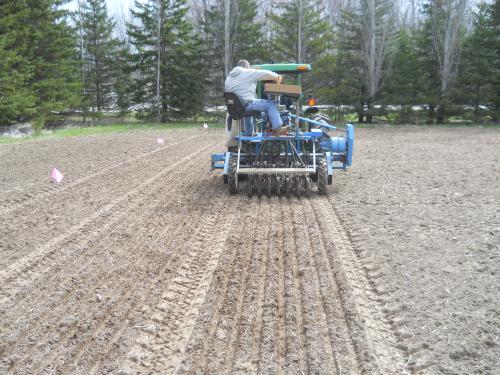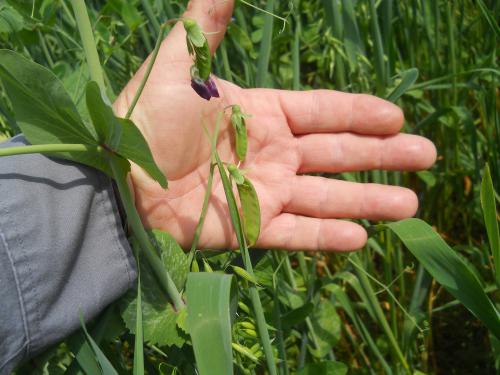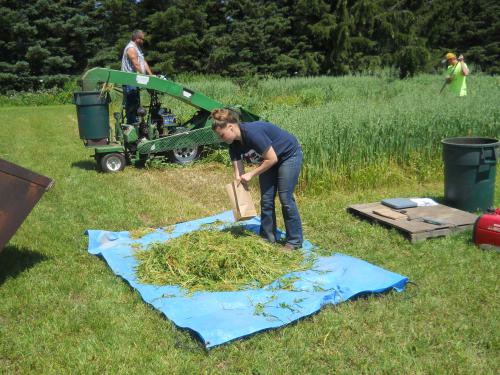Pea and oat trial in Upper Peninsula completed — Part 1: Yields
A replicated trial of four oat and pea combinations showed no significant yield differences between oat varieties at early or late harvest. However, the average yields based on harvest date were significantly different.

Oat and pea forage is planted widely across Michigan’s Upper Peninsula region as a nurse crop for perennial forage seedings and as a stand-alone annual forage crop. However, no recent research has been conducted to evaluate oat variety performance in combination with current, improved forage peas. Research conducted by North Dakota State University, University of Wisconsin and other institutions addresses some relevant aspects of oat and pea forage production, but from a significantly different growing environment.
The most recent regional evaluation of oat and pea forage was conducted by the Michigan State University agricultural experiment station in Chatham, Michigan, in 1988 using unspecified (probably Trapper variety) forage peas and unspecified oat and triticale varieties. In 2014, oat and field pea trials for grain production were conducted at Chatham. Regional, research-based information is needed to provide farmers with the ability to choose the best performing oat and pea forage variety combinations and time their harvest operations to produce the desired forage quality.
An on-farm set of forage oat comparison plots, planted by an interested Schoolcraft County farmer in 2016, revealed striking differences in maturity. This demonstration project was featured in an Aug. 18, 2016, MSU Extension article, “Oat and pea forage combinations.”
The 2017 trial conducted by MSU Extension educators Jim Isleib and Monica Jean included four forage oat selections mixed 50/50 by weight with 4010 forage peas. The oat varieties were selected based on farmer interest and included Ogle, Goliath, Everleaf 126 and Forage Plus. Trial sites included Manistique, Michigan (Schoolcraft County), planted May 5; the MSU Upper Peninsula Research and Extension Center in Chatham, planted May 8; and Carney, Michigan (Menominee County), planted June 6 due to wet soil conditions. The Carney site was later abandoned due to excessive damage from deer feeding.
Planting oat and pea forage.
The objectives of the trial included evaluation of performance (yield and feed quality) of the four oat and pea combinations and evaluation of the impact of harvest timing based on pea and oat stage of development. No hay seeding was included.
The first harvest was taken when the forage peas were in the “flat pod” stage on July 10 in Manistique and July 17 in Chatham. The second harvest was when the peas were in the “round pea” stage on July 19 in Manistique and July 27 in Chatham.
Forage peas at flat pod stage.
Table 1. Average oat and pea yields based on oat variety |
|
|---|---|
| Oat and pea variety mix | Yield (tons dry matter per acre) |
| Early harvest | |
| Everleaf 126/4010 | 2.9 |
| Forage Plus/4010 | 2.9 |
| Goliath/4010 | 2.8 |
| Ogle/4010 | 3.1 |
| Late harvest | |
| Everleaf 126/4010 | 3.1 |
| Forage Plus/4010 | 3 |
| Goliath/4010 | 3.1 |
| Ogle/4010 | 3.3 |
Table 2. Average oat and pea forage yields based on harvest date |
|
|---|---|
| Yield (tons dry matter per acre) | |
| Early harvest | Late harvest |
| 2.93 | 3.13 |
Sampling for quality and moisture.
There were no differences between yields based on oat variety at either early or late harvest. However, the average yields based on harvest date are significantly different. This is based on a 5 percent level of significance, the conventional statistical standard.
Keep in mind that this trial is based on only one year of information from the two locations during an unusually cool and wet growing season.
Part 2 of this article will discuss differences in feed quality among the different varieties and harvest dates.



 Print
Print Email
Email


